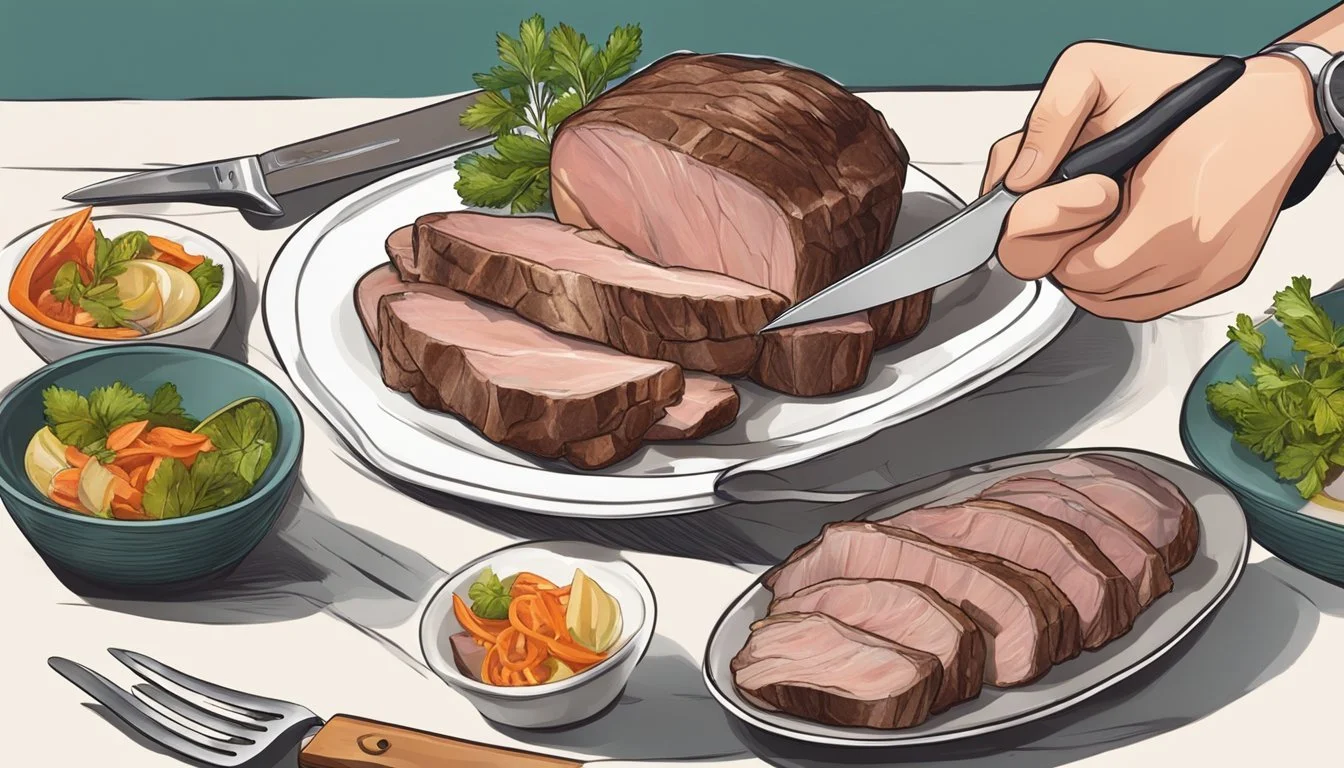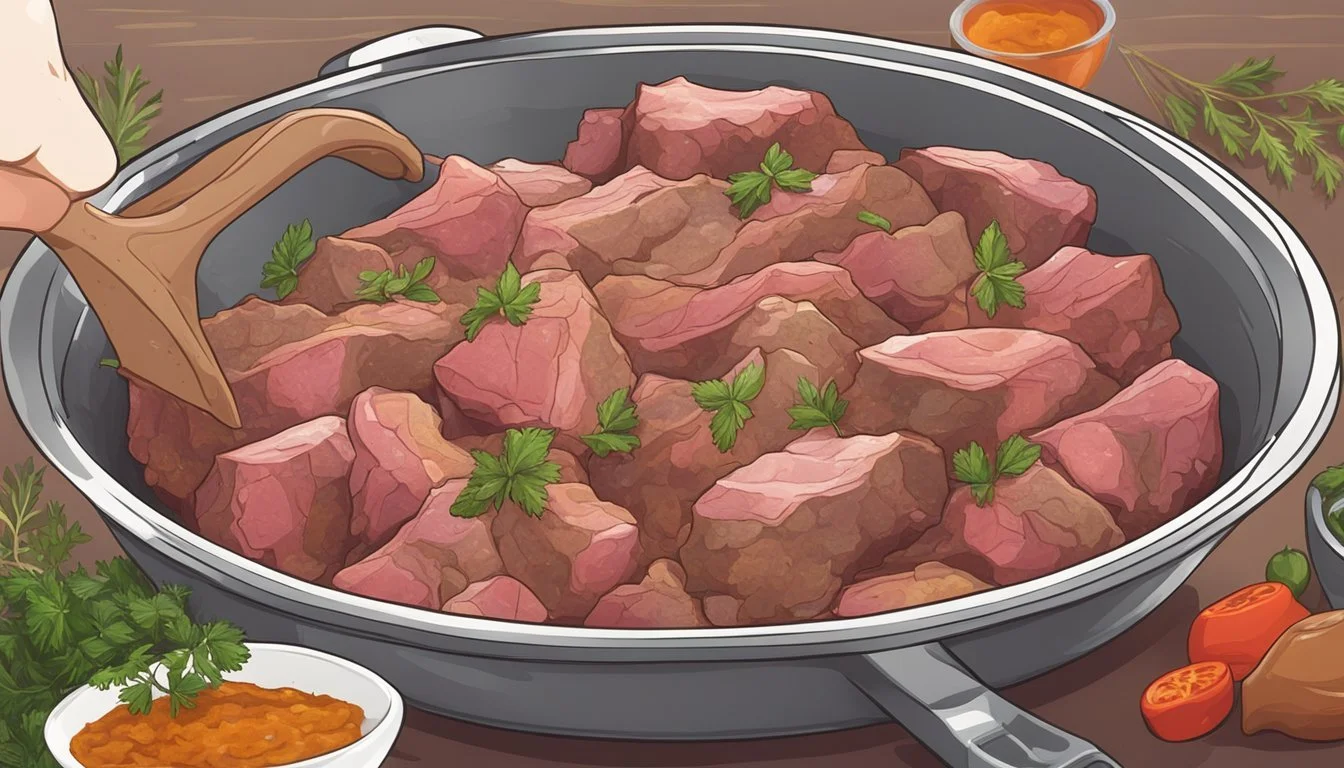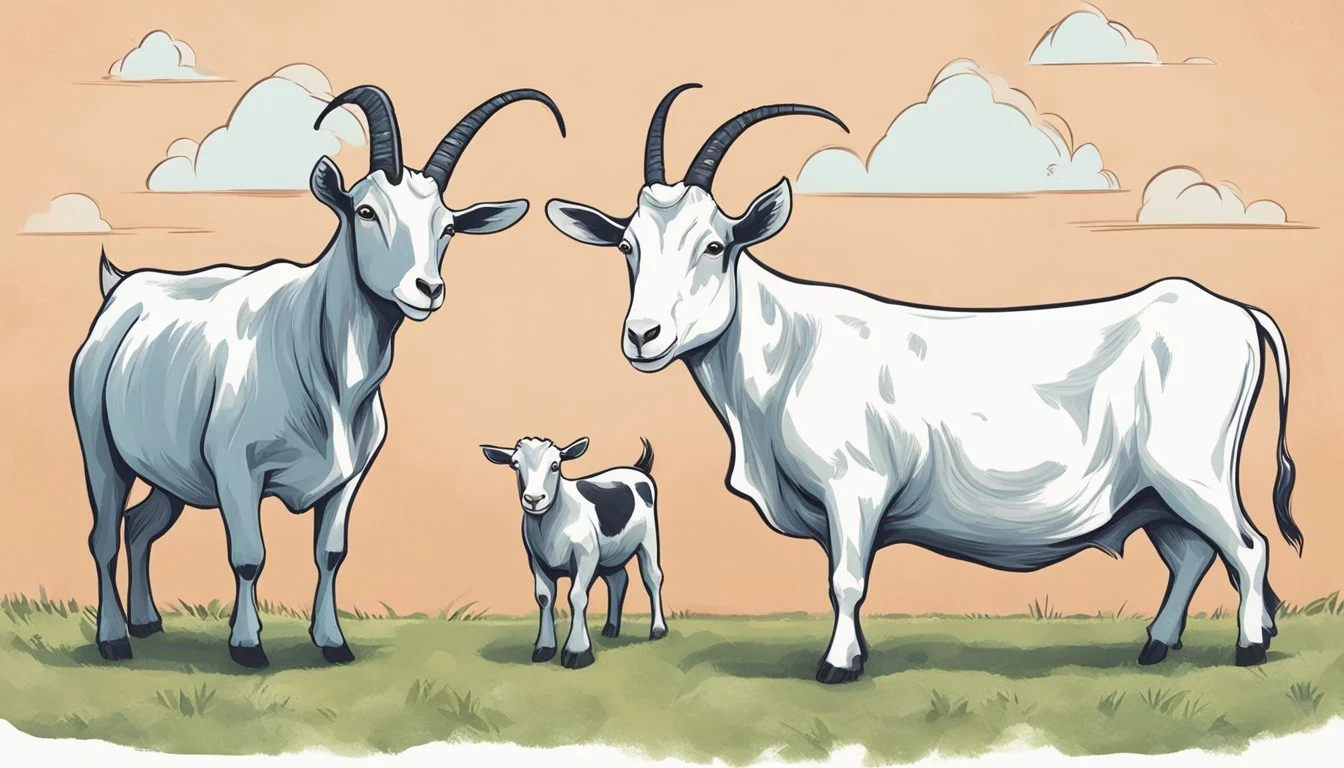How Do You Eat Goat Meat?
A Guide to Enjoying This Lean Protein
Goat meat is a dietary staple in many cultures around the world, acclaimed for its bold flavor and nutritional benefits. Known to be leaner than other red meats (What wine goes well with red meat?), it boasts a good balance of essential nutrients such as protein, iron, vitamin B12, zinc, and potassium. This profile, combined with low total fat and saturated fat content, positions goat meat as a healthier alternative for red meat enthusiasts.
In culinary practices, goat meat is as versatile as it is nutritious. It can be prepared in various forms—grilled, stewed, curried, or even baked—each technique imparting a distinct texture and depth of flavor. Marinating is a common first step in cooking goat meat, which helps to tenderize and infuse the meat with flavors ranging from subtle to spicy.
When it comes to consuming goat meat, cultural preferences and traditional recipes often guide the methods of preparation. The meat's adaptability to spices and herbs complements the culinary traditions of South Asian, Middle Eastern, African, and Caribbean cuisines. Each dish that features goat meat is an invitation to explore the rich tapestry of global gastronomy.
Nutritional Profile of Goat Meat
Goat meat is recognized for its rich nutritional value, providing essential vitamins and minerals, being a source of lean protein, and having a favorable fat content compared to other meats.
Comparative Nutrient Content
Goat meat is a significant source of protein, with a typical serving providing a substantial proportion of the daily recommended intake. When comparing goat meat with beef or chicken, it stands out as a lower-calorie option with less saturated fat. It is also notable for its iron content, which is higher than that of other red meats, making it a beneficial choice for preventing iron deficiency anemia.
Protein: High level, essential for muscle maintenance and repair
Iron: More abundant than in other red meats, critical for blood health
Saturated Fat: Lower than in beef or pork, advantageous for heart health
Health Benefits
In the context of vitamins and minerals, goat meat is particularly rich in vitamins B12 and riboflavin (B2), essential for energy metabolism and maintaining healthy skin and eyes. Its good zinc and potassium levels contribute to immune function and blood pressure regulation, respectively. Due to its balanced content of nutrients, goat meat can support a healthy diet when consumed in moderation.
Vitamins: B-vitamins such as B12 and riboflavin for energy and metabolism.
Minerals: Zinc for immunity, and potassium for cardiovascular health.
Lean Meat: Contains less fat, promoting a healthier weight and cardiovascular health.
Calories and Cholesterol
A 3-ounce portion of cooked goat meat contains approximately 122 to 143 calories, which is less than the caloric content of beef and chicken. While the cholesterol content is generally lower than that found in other red meats, mindful consumption is still advised, especially for individuals monitoring their cholesterol intake.
Calories: 122-143 per 3-ounce serving, fewer calories than beef or chicken.
Cholesterol: Moderate amount but less than many other red meats.
Preparation Basics
When preparing goat meat, the quality of the meat, the choice of ingredients for enhancing flavor, and the use of marinating techniques are crucial to achieving the desired tenderness and flavor.
Selecting Quality Meat
One must ensure they select the highest quality goat meat, which directly affects tenderness and taste. Fresh, well-sourced goat meat should have a rich red color, and the fat should be firm and white. Avoid meat that looks dry or has a slimy texture. Opt for younger goat meat, often referred to as "kid," for a less gamey and more tender result.
Essential Ingredients
The key to reducing the naturally gamey flavor of goat meat lies in the choice of ingredients. Bold spices and aromatics are essential. Use a combination of:
Salt and pepper: Basic yet essential for flavor enhancement.
Garlic and onions: Provide foundational flavors.
Spices: Incorporate a variety of spices such as cumin, coriander, cardamom, and cinnamon to add depth and diminish the strong taste.
Marinating Techniques
Marinating not only infuses the goat meat with a unique flavor but also aids in tenderizing tougher cuts. For effective marination:
Create a marinade using acidic components like lemon juice, vinegar or yogurt, which helps to break down the protein fibers.
Add spices and aromatics; garlic, onion, and herbs should be included to suit the desired flavor profile.
Marinate for an extended time: A few hours at the minimum, but ideally overnight, to allow the meat to become tender and flavorsome.
Cooking Methods
When cooking goat meat, selecting the appropriate method is essential for achieving the desired flavor and texture. Goat meat can be prepared using a variety of techniques, ensuring it's tender and enjoyable.
Roasting Guidelines
Roasting goat meat typically involves cooking it in an oven at high temperatures. This method works well for cuts like tenderloin or rib chops. For slow-roasted tenderness, the meat should be cooked at a low heat for an extended period. Maintaining moisture is crucial to prevent drying out, so one should often brush the meat with a marinade or cooking juices.
Preheat the oven to at least 375°F (190°C).
Cook until the internal temperature reaches 160°F (71°C) for medium doneness.
Stewing Instructions
Stewing is a slow cooking method that involves simmering the meat at low temperatures in a liquid. This is particularly suitable for tougher cuts of goat, as the lengthy cooking process allows the tough fibers to break down, resulting in melt-in-your-mouth tenderness.
Combine goat meat with aromatic herbs, spices, and a rich broth.
Simmer on low heat until the meat is tender.
Grilling Insights
Grilling imparts a unique flavor and is ideal for cuts that are best cooked over higher heat, like chops or steaks. Goat meat should be marinated to enhance flavor and retain moisture during the grilling process.
Preheat the grill to a medium-high temperature before adding the meat.
Grill to desired doneness, typically medium-rare or medium.
Popular Goat Meat Dishes
Goat meat is renowned for its versatility and rich flavor profile, often featured in a variety of dishes across numerous cuisines. With a tendency to absorb spices well, goat meat excels in curries and stews (What wine goes well with stews?), offering a robust taste that is both savory and complex. Below, two popular categories of goat meat recipes are discussed, illustrating the meat's adaptability in cooking.
Curries and Stews
Curries are a staple when it comes to cooking with goat meat. A classic dish such as curry goat is a cherished recipe in Caribbean cuisine, reflecting the perfect blend of spices and tenderness. The meat is typically marinated in a mix of curry powder, allspice, and other seasonings, then slow-cooked to perfection with ingredients like onions, garlic, scotch bonnet peppers, and either water or coconut milk for a rich, flavorful sauce. Tomato paste is also often included to add depth and a hint of sweetness to the curry. This dish pairs well with rice or flatbreads to soak up the deliciously spiced sauce.
On the other hand, stews take advantage of goat meat's ability to become exceptionally tender when cooked slowly. A hearty goat stew might incorporate vegetables, such as carrots and potatoes, with the meat being enhanced by stock, red wine, or a combination of both. Some stews might include a variation of spices, resembling the complexity of curries but with thicker, more concentrated sauces.
Roast Recipes
Roasting is another popular method to prepare goat meat, showcasing a different aspect of its flavor profile. When it comes to roast recipes, a slow-roasted goat shoulder is a prime example. This cut is best cooked at a lower temperature, allowing the connective tissue to break down over several hours, resulting in a tender and succulent roast. The meat might be seasoned with a simple blend of salt, pepper, and herbs, then placed in a roasting bag with a bit of water or a water and wine mixture to maintain moisture as it cooks.
Among the ground goat meat offerings, ground goat meatballs, often seasoned with a mix of herbs and spices, can either be fried or baked and served with a variety of sauces. Whether prepared in a tomato-based sauce or roasted with a glaze, they offer a flavorful alternative to traditional meatball recipes, highlighting the lean yet rich nature of goat meat.
International Cuisine
Goat meat is a versatile ingredient celebrated for its flavorful presence in various international culinary traditions. Each culture has its own unique methods for preparing, seasoning, and serving goat meat, often inspired by local ingredients and historical influences.
Asian Influences
In Asia, goat meat is a staple, with dishes such as the Indian Rogan Josh, wherein tender pieces of goat are slow-cooked in a complex curry made with a multitude of spices, including cardamom and cinnamon. The meat is frequently enjoyed with rice or bread, making it a quintessential part of the South Asian diet.
African and Caribbean Traditions
Across Africa, goat meat forms the cornerstone of many traditional dishes. For example, it is often grilled or stewed in rich sauces infused with native spices. In the Caribbean, goat curry is a sought-after dish marked by its bold use of allspice and Scotch bonnet peppers, delivering a dish with both heat and depth.
Mediterranean and Middle Eastern Dishes
The Mediterranean and Middle Eastern cuisines often feature dishes like the succulent goat stew, which may be seasoned with local herbs such as oregano, and served with sides of vegetables or grains. Kid goat (meat from a young goat) is particularly prized in these regions for its tenderness and is used in Italian capretto and Spanish cabrito preparations.
Comparing Meats
When deciding between types of red meat, consumers often weigh taste, nutritional value, and culinary use. This section compares goat meat to other common meats, specifically beef and lamb, focusing on their nutritional differences.
Goat vs. Beef and Lamb
Goat meat is leaner and contains less fat than both beef and lamb. Beef is known for its richness and marbled fat, which contributes to flavor and moisture. Lamb typically has a distinctive, gamey flavor, and while it is also rich in fat, its meat tends to be slightly leaner than beef but fattier than goat.
Goat meat's lower fat content results in a less marbled texture but also signifies that it is typically a healthier choice for those looking to reduce their fat intake. The flavor of goat can be described as mild with a hint of gamey-ness, less pronounced than that of lamb. Due to its leanness, goat meat benefits from slower cooking methods to maintain tenderness and moisture.
Nutritional Differences
When it comes to nutrition, each meat has its unique profile. Goat meat stands out particularly in the following aspects:
Protein and Fat: Goat meat is a good source of lean protein and has considerably less saturated fat than beef and lamb, making it a healthier choice for heart health.
Iron: It is rich in iron, surpassing the iron content in both beef and generally pork.
Vitamins: Goat meat offers an abundance of vitamin B12 and a fair amount of zinc and potassium.
Calories: With fewer calories per serving compared to beef and lamb, goat meat supports those mindful of their calorie intake.
Below is a brief nutritional comparison:
Nutrient Goat (per 3 oz) Beef (per 3 oz) Lamb (per 3 oz) Calories Less More More Saturated Fat Lower Higher Moderate Iron Higher Lower Lower Protein High High High
It is crucial for consumers to examine these nutritional differences to make informed choices that align with their health and dietary goals.
Butchery and Cuts
The section focuses on the various parts of goat meat available and offers insights on what consumers should consider when purchasing goat cuts.
Understanding Cuts
Goat meat is sectioned into various cuts, each suitable for different cooking methods. The shoulder is flavorful and ideal for slow cooking, turning tender when braised or stewed. The loin produces tender cuts and can be roasted or grilled to maintain its juicy quality. Chops, taken from the loin, offer quick-cooking possibilities and are often grilled or pan-fried. The goat leg and leg steaks are substantial cuts perfect for roasting or grilling, especially in Mediterranean recipes. The term cabrito typically refers to a young milk-fed goat, while capretto denotes a slightly older, grass or grain-fed goat; their tender meat is prized in various cuisines. Chevon is the meat from older goats and is known for its richer flavor. The Boer goat breed is renowned for its high-quality meat. When butchering, the cheeks are sometimes overlooked but provide tender and flavorful morsels when cooked slowly.
Buying Tips
When purchasing goat meat, consumers should look for cuts with a rich, deep color and firm texture. For specific dishes, one should consider:
Roasting or grilling: Select loin cuts, chops, and leg steaks.
Slow cooking: Opt for shoulder cuts, which become tender through lengthy cooking.
When choosing a young goat like cabrito or capretto, their meat will be paler and softer, suitable for delicate cooking methods. Conversely, the darker, firmer meat of chevon lends itself to robust, flavorful dishes. Buyers interested in sustainable and ethically sourced meat should inquire about the origin of the meat, preferably opting for locally sourced goat where possible.
Cultural Significance and Usage
Goat meat carries diverse cultural significance across global societies, often intertwined with religious rituals and traditional celebrations. The versatility of its usage reflects both its culinary importance and the socio-cultural practices that surround its consumption.
Traditional Celebrations
Easter: In Greek culture, dishes such as Kokoretsi are hallmarks of Easter, embodying both a celebration of spring and religious reverence. Goat meat, recognized for its flavor and tenderness, becomes central to feasting and family gatherings during this time.
Hispanic Festivities: Within Spanish and other Hispanic communities, cabrito—which is meat from a young goat—is commonly served at various festivities, symbolizing both tradition and communal growth. Its presence in a feast denotes a special occasion, and it has found its way to farmers’ markets as a sought-after delicacy.
Ritual and Folklore
Religious Practices: In many religious traditions, goats are sacrificed as part of ceremonial practices. Goat meat is then distributed and consumed as a sign of blessing and spiritual enactment. The tissues of the goat, holding symbolic value, are shared within communities to signify unity and faith adherence.
Folk Medicine: In some cultures, parts of the goat, such as the testicles, are considered an aphrodisiac or a source of virility, often termed 'mannish water'. This belief extends beyond mere nutrition, ingraining goat meat within the folklore as a substance with the power to enhance vitality and manhood.
In these ways, goat meat remains not only a culinary ingredient but also a vibrant part of the cultural tapestry that defines various societal rituals and beliefs.
Health Considerations
When eating goat meat, individuals can consider its health impacts, particularly in relation to its nutritional profile. Goat meat can play a role in a balanced diet, offering specific health benefits while also requiring a careful approach to portion and frequency.
Dietary Impacts
Goat meat is a healthy choice within a balanced diet, offering a rich source of essential nutrients. It is known for its high-quality protein content, which plays a crucial role in muscle maintenance and repair. Additionally, it provides a good amount of collagen, which is beneficial for skin, bone, and joint health.
The meat is comparatively low in cholesterol and fat, especially saturated fat, when placed against other red meats. This can make it a favorable option for individuals watching their cholesterol levels. In particular, the LDL (low-density lipoprotein) cholesterol, often referred to as 'bad' cholesterol, is of concern for many individuals when choosing meats. Regular consumption of meats high in saturated fat and cholesterol may potentially raise LDL cholesterol levels, but goat meat's lower levels may make it a more suitable alternative within a diet aimed at maintaining or reducing LDL cholesterol.
To maintain these benefits, one should consider how goat meat is prepared and what it is served with. The healthiest cooking methods include grilling, roasting, or stewing, rather than frying, which can add unnecessary fats. Additionally, serving goat meat with a variety of vegetables can further improve its health benefits.







